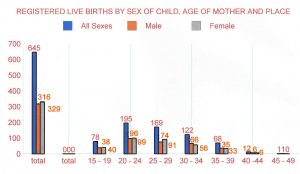Franz Kröger
The 2018 Mid-Year Performance Review
(Bulsa North District)
Thanks to Robert Asekabta who drew my attention to this report and Hon. David Amoabil Afoko (DCE) who gave me permission to print extracts of it.
The report is prepared semi-annually in connection with the Medium Term Development Plan (MTDP) 2018-21, which was developed by the Bulsa North District Assembly (BNDA).
The mid-year review describes both the pre-planned programmes and projects and how far they have been implemented or completed over the past six months.
Physical Project
The “physical projects” are important for the development of Bulsaland. Only a few of the completely finished ones can be mentioned here.
• Construction of a 3-unit classroom block, staff room, office and store in Chuchuliga (Funding agent: District Assembly Common Fund, DACF)
• Construction and installation of 20 district-wide boreholes (DACF)
• Completion of a medical theatre at the district hospital (Funding agent: District Development Facility, DDF)
• Rehabilitation of 3 schools in Zundema, Kalijiisa and Suwarinsa (DDF)
• Construction of several CHPS (Community Based Health Planning and Service Compounds), e.g. in Wiaga-Kom, Wiaga-Chiok, Yikpien (DACF and DDF)
• Renovation and furnishing of the Siniensi and Wiaga area councils (DACF)
• Procuring furniture for the key offices of the District Assembly Hall (DACF)
As a barrier to the successful implementation of many projects, the following reasons are cited (among others):
• Delays in the release of funds from the Central Government…
• Difficulty of DPCU [District Project Coordination Unit] secretariat in obtaining quality and timely data/information from decentralized departments…
• Inadequate logistics for the secretariat to adequately organize service meetings…
Agricultural Development
According to the review, “agriculture is one of the major sources of income for the people of the District with about 80% engaged in the agriculture sector”.
All major crops (maize, rice, sorghum, millet, groundnut, soya beans, tomatoes, onions, pepper, sweet potatoes) saw an increase in production.
The increase in livestock farming is as follows:
Change in selected livestock
Animals | District baseline 2017 (numbers) | 2018 achievement level |
| Cattle | 36,801 | 38,641 |
| Sheep | 16,529 | 27,856 |
| Goats | 28,620 | 30,051 |
| Pigs | 1,599 | 2,679 |
| Local Fowls | 41,532 | 43,609 |
| Guinea Fowls | 33,416 | 35,089 |
| Donkey | 1,345 | 1,603 |
Registered Live Births
![]()
![]()
![]()

In addition to a large amount of data in the texts and tables, the review also contains a diagram of the “registered live births” of the Bulsa North District.
The very title raises the question about the number of non-registered live births in Bulsaland. We can perhaps assume that the rate is often below 50% in traditional farmsteads, far above 50% in modern settlements and probably at 100% for hospital births.
The diagram also shows the age of the mothers at the time of birth. While most percentage data probably correspond largely to those of other countries , the high proportion of teen-aged mothers is striking. In the traditional compounds of the past, these figures may have been even higher, but they probably had fewer negative effects since the child of a teen-aged mother found the same loving care and attention as those of older mothers. In modern times, however, we must assume that a very large proportion of the 15-19-year-old mothers are still schoolgirls or have not yet completed their training for a practical job. This can either lead to problems with regard to constant nursing and care for the child or to the interruption of the mother’s (school) education.
Following the diagram, some brief information about the place of birth is mentioned. 630 births having occurred in hospitals and clinics are compared to 15 births in (private) houses and compounds. With regard to this very strong contrast, we should consider that only the registered births were recorded and that mothers giving birth in a hospital/clinic are usually obliged to register their child while this is done less frequently for babies born in a compound. Including unregistered births in a statement concerning the place of birth would certainly result in showing a higher number of births having taken place in parental compounds.
—
The compilation of the mid-year performance review certainly required a lot of work and effort. In our opinion, the results were worth the efforts because scientifically conducted statistics are indispensable for meaningful development planning. They show both the success of development projects in undisputable figures, but they also reveal which gaps still need to be closed for successful future development work.
- Coverpage
- Editors, Notes for Contributors and Copyright
- Editorial
- Events (Franz Kröger, Robert Asekabta, Cornelius Adumpo, John Agandin et.al.)
- Maaka Projects in Gbedema 2017-2018 (Christine Arnheim)
- My Journey to France (Robert Asekabta)
- The 2018 Mid-Year Performance Review – Bulsa North District
- Discussions in the Facebook Group “BULUK KANIAK”
- Who on Earth is Interested in the Bulsa? (Franz Kröger)
- Cultural Heritage and the Possibilities of Tourism (Franz Kröger)
- Feok Festival 2017 Review (Augustine A. Atano)
- The Bulsa Feok — Accra Chapter (John Agandin)
- Two Poems: A Tale of Footprints and The Baobab (John Agandin)
- Some Objects of Bulsa Material Culture
- Bulsa Districts (Map)
- Back cover of the printed edition